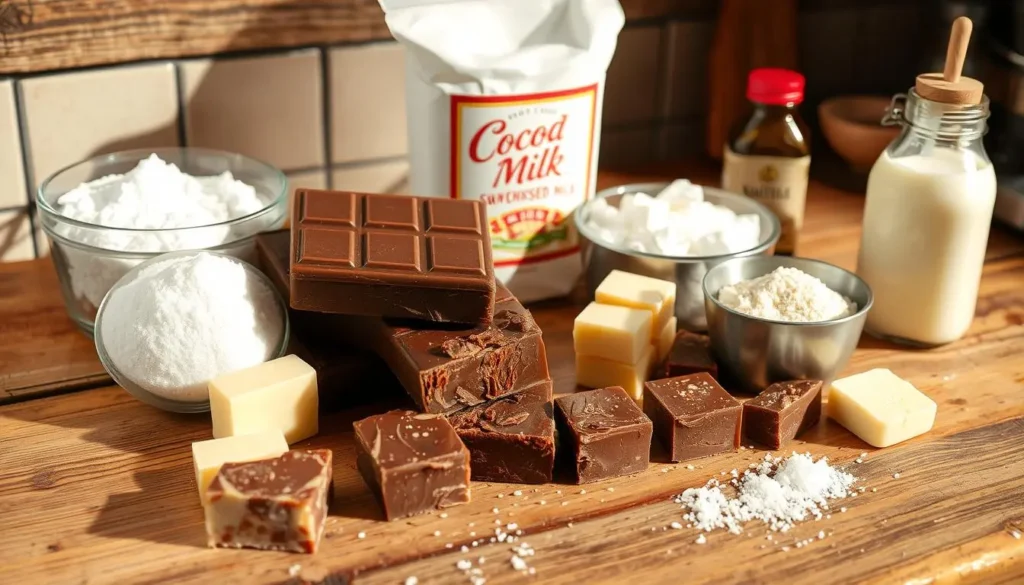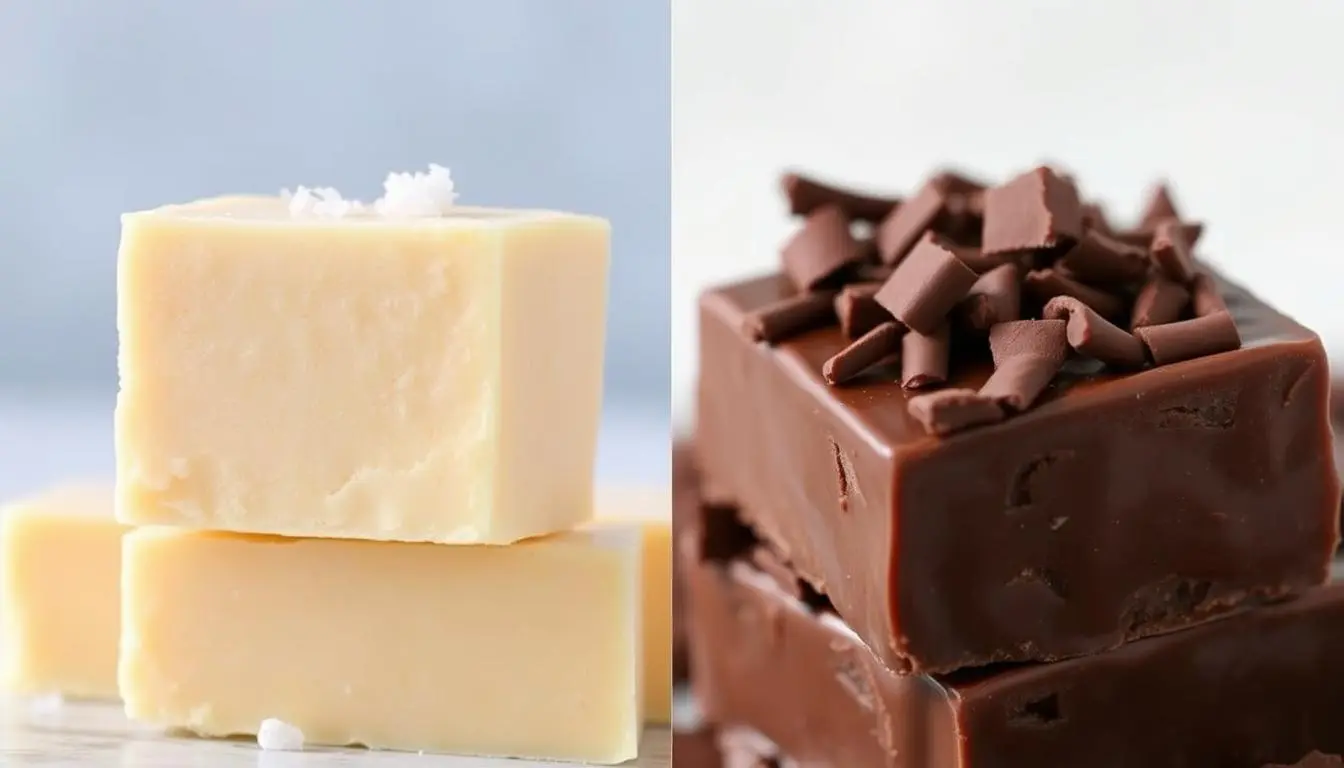Fudge and chocolate fudge are two beloved treats in the world of sweets. They both have a rich, creamy texture and are sweet. But, knowing the differences between them is key for candy lovers. This article will explore their origins, ingredients, and unique qualities.
We’ll dive into the history of these sweets, the science of their texture, and the wide range of flavors. Whether you love fudge or just want to learn more, this guide will satisfy your sweet tooth and broaden your knowledge.
Understanding the Basic Origins of Fudge Making
Fudge, a sweet treat, has a long history in the United States. It started in the late 1800s with an accident in a college lab.
Historical Evolution of Fudge in American Confectionery
In the 1880s, Vassar College students were trying to make chocolate caramel. They accidentally made a soft, smooth treat that became fudge. This discovery quickly made fudge popular in American sweets.
Traditional Fudge-Making Techniques
Making fudge involves careful temperature and timing control. Recipes mix sugar, milk, butter, and flavorings like vanilla or chocolate. The mix is heated, then cooled and stirred to get the creamy texture we love.
New fudge ingredients and methods have brought many flavors to fudge. Yet, the traditional ways are still key to many sweet delicacies today.

The Core Components of Traditional Fudge
Classic fudge making is all about finding the right mix of ingredients. Sugar, butter, and milk are the key players. Together, they create the fudge’s fudge texture and rich fudge flavor. Knowing how each ingredient affects the candy making process is crucial for making great fudge.
Sugar is the main ingredient in fudge, adding sweetness and texture. Most recipes use white sugar, but some may mix in brown sugar or maple sugar for extra flavor.
- Butter makes fudge creamy and indulgent, helping to get the right fudge consistency. The amount of butter used is important for the perfect fudge texture.
- Milk, whether whole, cream, or a mix, holds the ingredients together. It adds to the fudge’s rich taste and smooth creamy texture.
By balancing these main fudge ingredients, makers can create the ultimate traditional fudge. It’s a treat that pleases with its luscious texture and rich flavor profile.
What’s the difference between fudge and chocolate fudge?
In the world of sweets, fudge and chocolate fudge are often confused. They share some similarities but have key differences. These differences make each treat unique.
Key Ingredients That Set Them Apart
The main ingredient is what makes them different. Traditional fudge uses sugar, butter, and milk or cream. On the other hand, chocolate fudge adds cocoa powder or melted chocolate. This gives it a rich, chocolatey taste.
Texture and Consistency Variations
The chocolate in chocolate fudge changes its texture. It’s silkier and smoother than traditional fudge. Chocolate fudge is also firmer and denser, while traditional fudge is softer and creamier.
Flavor Profile Distinctions
Chocolate fudge has a more complex taste. It includes flavors of cocoa, vanilla, and sometimes coffee or spices. In contrast, traditional fudge is sweeter. It’s mainly known for its rich, buttery taste from the dairy ingredients.
Knowing the differences between fudge and chocolate fudge helps you choose. Whether you like the classic taste of traditional fudge or the rich taste of chocolate fudge, there’s a perfect fudge for you.
Essential Ingredients in Chocolate Fudge Making
Making the perfect chocolate fudge recipe begins with choosing the right ingredients. The main parts that make chocolate fudge special are the different types of chocolate and cocoa. These are key to its taste and texture.
Top-notch chocolate is the base of any great chocolate fudge. Bakers mix semisweet, dark, and milk chocolate for the best taste. The cocoa solids in the chocolate also affect the flavor.
Butter, sugar, and cream or milk are also important fudge ingredients. They help make the fudge smooth and creamy. This is what makes chocolate fudge stand out from other confectionery treats.
| Ingredient | Purpose |
|---|---|
| Chocolate (semisweet, dark, milk) | Provides the distinctive chocolate flavor and richness |
| Butter | Contributes to the smooth, creamy texture |
| Sugar | Sweetens the fudge and aids in the crystallization process |
| Cream or Milk | Adds creaminess and moisture to the fudge |
By picking and mixing these key fudge ingredients carefully, bakers can make a chocolate fudge recipe. It will be rich, indulgent, and velvety.
The Science Behind Fudge Texture
Making perfect fudge is an art that needs science knowledge. The secret to a creamy, smooth texture is in sugar crystallization and temperature control.
Crystal Formation Process
Fudge texture comes from sugar crystals formed when it cools. When heated, sugar dissolves into the liquid, creating a supersaturated solution. As it cools, sugar molecules crystallize, making fudge smooth and creamy.
Temperature Control Importance
Temperature is key in candy making and dessert recipes like fudge. The best cooking temperature is between 234°F and 240°F (112°C and 116°C). This ensures small, uniform sugar crystals. Keeping the temperature right is crucial for a smooth fudge texture.
Achieving Perfect Consistency
- Properly temper the fudge mixture to ensure even crystal formation and distribution.
- Carefully control the cooling rate to promote the growth of small, uniform sugar crystals.
- Incorporate air bubbles during the mixing process to create a lighter, creamier fudge texture.
Knowing the science of fudge texture helps candy makers and dessert chefs make delicious fudge. They can create rich, velvety fudge that pleases everyone.
Popular Variations of Non-Chocolate Fudge
While Cocoa fudge is well-known, there’s a world of fudge to discover. From vanilla to peanut butter, and maple-infused, these options are a nice change from chocolate. They offer a sweet contrast to the usual chocolate treats.
Vanilla fudge is a favorite for its creamy and smooth taste. It’s a classic that lets the fudge’s sweetness shine. For those who love nuts, peanut butter fudge is a treat. It mixes peanut butter’s richness with fudge’s creamy texture.
Maple fudge is another favorite, with its natural maple syrup sweetness. It adds a unique flavor, often with a caramel taste. It’s a great choice for those looking to try something new.
These non-Cocoa fudge types show the creativity in fudge making. They offer a wide range of flavors, proving that fudge can be more than just chocolate.
Mastering the Art of Chocolate Fudge Creation
Making perfect Cocoa fudge is an art that needs focus and knowledge of candy science. The basic recipe looks easy, but many mistakes can happen. By avoiding these errors and using expert tips, you can make your Cocoa fudge recipe stand out. You’ll wow your friends and family with your sweet-making skills.
Common Pitfalls to Avoid
Temperature control is key in making great Cocoa fudge. If the mix gets too hot or not hot enough, it can be grainy or not set right. Also, wrong ingredient amounts or mixing can ruin your fudge.
Professional Tips and Tricks
To make sure your Cocoa fudge is perfect every time, try these expert tips:
- Use a candy thermometer to check the mix’s temperature.
- Add ingredients in the right order, mixing each fully before adding the next.
- Choose top-quality chocolate and ingredients for the best taste and texture.
- Learn to temper the chocolate for a shiny, smooth finish.
- Try different mix-ins like nuts, dried fruit, or spices to make unique dessert recipes.
By avoiding common mistakes and using these expert methods, you’ll make the most delicious Cocoa fudge ever.
You May Also Like:
- Easy Frozen Chicken Crock Pot Recipes for Dinner
- Why Cut Bologna Before Frying? Tips for Perfect Slices
- Can You Use Egg Whites in Burgers? | Cooking Tips
- Egg White Burger Buns Recipe: Healthy, Low-Fat, and High-Protein
Storage and Shelf Life Differences
Understanding how to store fudge is key to keeping its texture and taste. The fudge texture greatly affects how it should be stored. This is true for both traditional and chocolate fudge.
Traditional fudge is softer and creamier than Cocoa fudge. It needs gentle handling and cool storage to stay perfect. Keep it in an airtight container at 50-70°F to avoid drying out or becoming grainy.
Chocolate fudge, with its richer taste, lasts a bit longer. It can stay fresh for 2-3 weeks when stored right. The cocoa and chocolate in it help keep the fudge’s sweet delicacies and texture longer.
| Fudge Type | Shelf Life | Storage Conditions |
|---|---|---|
| Traditional (Non-Chocolate) Fudge | 1-2 weeks | Airtight container, 50-70°F |
| Chocolate Fudge | 2-3 weeks | Airtight container, 50-70°F |
Proper storage is crucial for keeping fudge’s texture and taste. Knowing the right storage tips helps your fudge stay fresh and delicious for a longer time.
Conclusion
The main difference between fudge and chocolate fudge is their ingredients and taste. Both are loved for their sweet treats, but they taste and feel different. Fudge is creamy and sweet, often with nuts or fruits. Chocolate fudge, on the other hand, is richer and more intense because of cocoa.
We’ve looked at how fudge has changed over time, the science behind its texture, and the many types of fudge without chocolate. Whether you love fudge or chocolate, learning about their differences can lead to new favorites.
Next time you want something sweet, try both fudge and chocolate fudge. They offer unique tastes and textures. Explore the wide world of sweets and find what you like best.
FAQs
What are the key ingredients used in making fudge?
Sugar, butter, and milk are the main ingredients for traditional fudge. They mix to create fudge’s smooth, creamy texture and rich flavor.
How does the texture and consistency of fudge and chocolate fudge differ?
Fudge is softer and creamier than chocolate fudge. Chocolate fudge is denser because of the chocolate or cocoa powder. This makes chocolate fudge grainier or denser.
What are some common non-chocolate fudge varieties?
There are many non-chocolate fudge types, like vanilla, peanut butter, maple, and rocky road. These flavors give unique tastes while keeping the classic fudge texture.
What are the key steps in making perfect chocolate fudge?
Making perfect chocolate fudge needs careful temperature control and proper mixing. Understanding sugar crystallization is key. Avoiding mistakes and following expert tips ensures a smooth chocolate fudge.
How do the storage and shelf-life requirements differ between fudge and chocolate fudge?
Fudge and chocolate fudge have different storage needs. Fudge lasts longer and can be kept at room temperature. Chocolate fudge needs refrigeration to keep its texture and prevent blooming.

